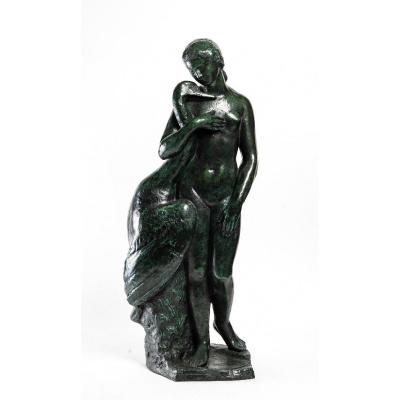Title: Chant de L'Alouette
Material: Bronze with light patina
Dimensions: Approximately 81 cm high x 30 cm wide (31.9 inches high x 11.8 inches wide)
Description:
This exquisite 19th-century bronze sculpture, titled "Chant de L'Alouette," was created by the renowned French sculptor Hippolyte Moreau. The sculpture beautifully represents a young French woman displaying her charm by reproducing the song of a lark. She is depicted barefoot, resting on a flowering stump, and holding a tree branch in her left hand. Her right hand is raised to her face, enhancing the lifelike quality of her pose. She is dressed in a peasant costume, complete with a hat and a half-knitted bodice, embodying the pastoral elegance of the era.
At her feet, a bird's nest with two chicks adds to the naturalistic scene, further emphasizing the connection to nature and the song of the lark.
Base and Signatures:
The sculpture stands on a circular naturalistic base and a circular stepped plinth, which features a title plaque inscribed with "CHANT DE L'ALOUETTE PAR HTE MOREAU MEDAILLE AU SALON." The piece is signed twice: once on the signature block with "Chant de l’Alouette par Hte Moreau, Médaillé au Salon," and again at the lower part of the sculpture, ensuring its authenticity and highlighting Moreau's acclaim as a medallist at the Salon.
Historical Context:
This sculpture is a remarkable example of late 19th-century French artistry. Hippolyte Moreau was known for his ability to capture the delicate beauty and charm of everyday scenes and individuals, often imbued with a sense of poetic realism. "Chant de L'Alouette" is a testament to his skill in bringing to life the grace and simplicity of rural French life through bronze.
This piece not only exemplifies the technical and artistic prowess of Moreau but also serves as a historical artifact, reflecting the cultural and artistic values of 19th-century France. It is a significant work for collectors and admirers of fine art, embodying the elegance and heritage of the period.






























 Le Magazine de PROANTIC
Le Magazine de PROANTIC TRÉSORS Magazine
TRÉSORS Magazine Rivista Artiquariato
Rivista Artiquariato
